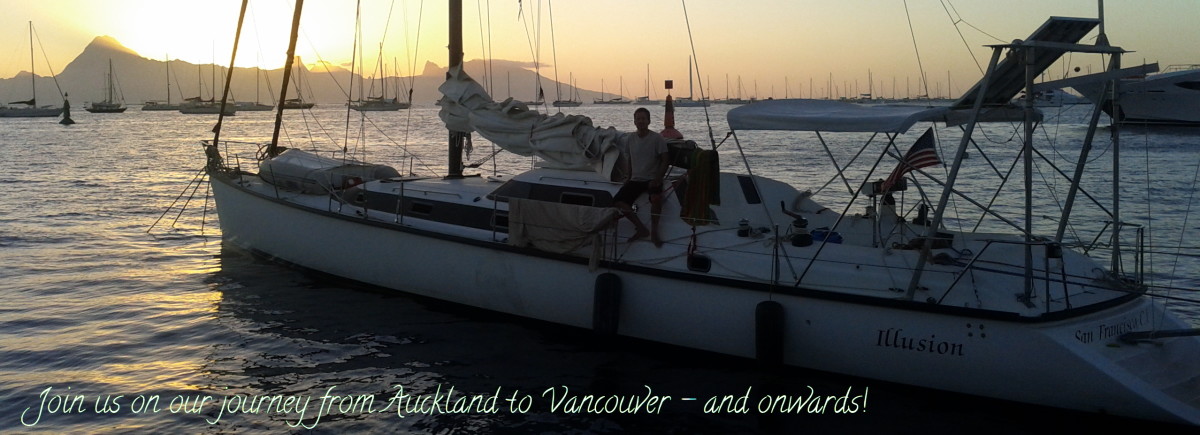 Loreto, the furthest north we got in the Sea of Cortéz, is mostly known to visitors for its fishing and for being the site of the first “successful” mission in Baja California. The Jesuits, led by Juan María Salvatierra, sailed the Santa Elvira from Sonora to arrive in the indigenous dwelling of Conchó in October 1697. Although only a few weeks after their arrival local indigenous people attacked the mission, the Mission of our Lady of Loreto became a cornerstone of the peninsula religious network.
Loreto, the furthest north we got in the Sea of Cortéz, is mostly known to visitors for its fishing and for being the site of the first “successful” mission in Baja California. The Jesuits, led by Juan María Salvatierra, sailed the Santa Elvira from Sonora to arrive in the indigenous dwelling of Conchó in October 1697. Although only a few weeks after their arrival local indigenous people attacked the mission, the Mission of our Lady of Loreto became a cornerstone of the peninsula religious network.
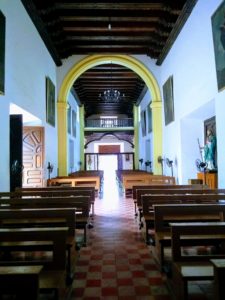
Later, after the Jesuits were evicted, Franciscan Junípero Serra sailed up from San Blas on the Purísima, a two week voyage crossing over from the mainland, no doubt battling against some of those strong northerlies we experienced while exploring the area, and it was from here he later departed to head to San Diego and found the California missions.
We sailed up from La Paz to Puerto Escondido in February (it was a bit windy to anchor at Loreto, though in some conditions it can work to do that) via some of the most amazing scenery I’ve ever seen. Baja just got better and better for me as we explored the gorgeous islands and rocky coves. I’ve written about some of our experiences here, here, and here – I was totally blown away by the drama of the landscape. And now, after travelling down Mainland Mexico and having arrived in El Salvador, despite all the great places we’ve visited, it’s Baja and its waters that I’m still craving.

Puerto Escondido was, unexpectedly, a great place for us. We used a mooring ball so it was affordable (the dock prices, not so much!), and the marina facilities and staff really impressed us. There’s a good marina shop, which although a bit pricey had a great selection, along with a little cafe, and was the first place in ages we were able to find peanut butter without added sugar! 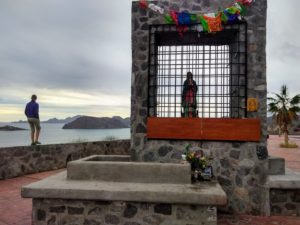 There’s laundry, water, nice showers, a little pool, a nice bar with great pizza, and, a highlight for me, some abandoned buildings to check out. But, apart from that, there’s nothing much on land easily accessible nearby, and a main reason for going was to visit Loreto. The marina will organize a rental car for you and it’s an easy ride there up the main road, with views out over the islands.
There’s laundry, water, nice showers, a little pool, a nice bar with great pizza, and, a highlight for me, some abandoned buildings to check out. But, apart from that, there’s nothing much on land easily accessible nearby, and a main reason for going was to visit Loreto. The marina will organize a rental car for you and it’s an easy ride there up the main road, with views out over the islands.
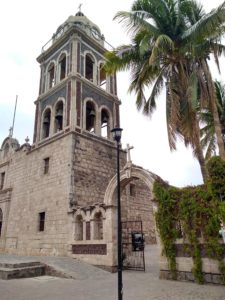
So off we went, squashed into a car with the crew of SV Goblin, to explore. The mission museum tells some of the area’s history including a brief, devastating account of the decline in the indigenous population in Baja California – from an estimated 41,500 people in 1697 to under 4000 by 1773. But it was Alejandro Curiel’s art in the town hall on the main plaza, combining birds, plants, myths, history, and the people and traditions of the area, that brought history to life and helped to make sense of things for me. We were only in town briefly and the artist was busy with getting an exhibition ready so I didn’t get to meet him, but we exchanged a few emails so I could find out more about his work and life as an artist on the Baja peninsula.
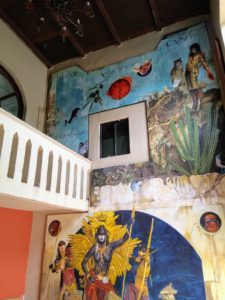
The mural in the town hall covers the four walls of a big entrance stairway (go in through the gallery area and carry on to the back of the building) with each ‘panel’ representing a stage in the region’s history: beginning with the amazing wildlife of the area, Queen Calafia, and the indigenous peoples, followed by the arrival of the Catholic church in its various orders, moving on through representations of more recent cattle ranches and musicians, to arrive at the final panel showing the new generation of inhabitants of Loreto, with local children, many of them Curiel’s students, as models. The work is dramatic and compelling, full of mysticism, hints of violence, Latin phrases, and symbolism. Even without knowing much of the area’s history, these scenes are loaded with desire, fear, suspense, and wondering.
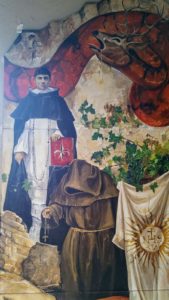
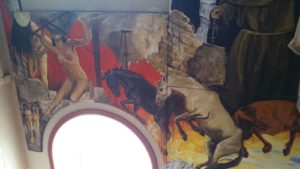
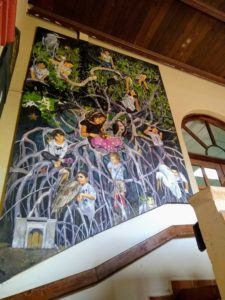
The final panel seems to offer some vision for the future of the region: a new generation of differing ethnicities, races, and nationalities, intertwined through the roots and branches of the mangroves. Each figure sits separately but is nevertheless connected to the others. “Baja is made up of local people and many more who come from outside, and that’s what’s interesting, the interaction of different visions in this small society,” points out Curiel.
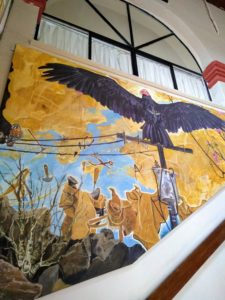 Along with the history of the people of the region, throughout the mural and other works by Curiel are gorgeous, rich depictions of the bird and plant life of the area. For me, visiting Baja was like entering a whole new world. I was constantly struck by the simultaneous scarcity and abundance: it’s a vast, rocky, bare landscape from a distance that starts to reveal itself as you look more closely. What looks like emptiness becomes, at closer contact, a place buzzing with life – snakes, lizards, butterflies, cactus, daisies, frigatebirds and turkey vultures, mangroves, and even wild fig trees fill the spaces with colour, growth, and activity. It’s a great blessing to live in the desert, because of the land’s poetry,” says Curiel, “the animals always teach you something new”.
Along with the history of the people of the region, throughout the mural and other works by Curiel are gorgeous, rich depictions of the bird and plant life of the area. For me, visiting Baja was like entering a whole new world. I was constantly struck by the simultaneous scarcity and abundance: it’s a vast, rocky, bare landscape from a distance that starts to reveal itself as you look more closely. What looks like emptiness becomes, at closer contact, a place buzzing with life – snakes, lizards, butterflies, cactus, daisies, frigatebirds and turkey vultures, mangroves, and even wild fig trees fill the spaces with colour, growth, and activity. It’s a great blessing to live in the desert, because of the land’s poetry,” says Curiel, “the animals always teach you something new”.
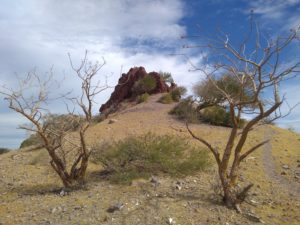
There isn’t much fresh water, though, as sailors will be well aware (although Puerto Escondido does have potable water at the docks and we were very happy to be able to fill up our tank before leaving!) and this desert landscape struggles to provide much in the way of food for its people. Resources and materials in general can be hard to obtain. Added to that, hurricanes and strong rains come through adding a feeling of temporariness and precarity to many of the villages. (Just yesterday we were hearing about the hurricane damage done there to the boat of a fellow-cruiser we’ve met here in El Salvador) “It’s difficult to get what you need. That’s been part of my work since I did the mural, I have to get a huge stock of materials to last at least six months. I buy rolls of canvas, buckets of primer, big tubes of oils. Lots of paintbrushes. And that’s made it possible to be a small supplier of art materials for the community. 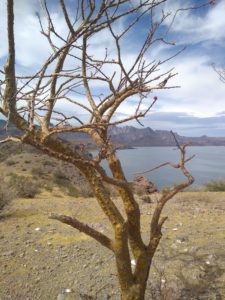 The big problem is always connectivity and the long delivery process. We live on a large “island”, all of Baja Sur is like that. It’s anachronistic. La Paz, as the capital, is a bit more up-to-date, but it’s still about a decade behind the rest of the country in terms of infrastructure and services. And in the small towns life is still like it was fifty years ago, in some places in the desert nothing much has changed since the time of the missionaries.”
The big problem is always connectivity and the long delivery process. We live on a large “island”, all of Baja Sur is like that. It’s anachronistic. La Paz, as the capital, is a bit more up-to-date, but it’s still about a decade behind the rest of the country in terms of infrastructure and services. And in the small towns life is still like it was fifty years ago, in some places in the desert nothing much has changed since the time of the missionaries.”
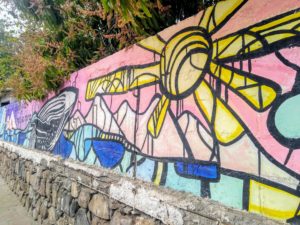
Much of Baja feels quite isolated, but Loreto is one of the busier towns, with a constant stream of tourists, and what seems to be a thriving cultural scene, with exhibitions, an Artwalk during which artists open up their studios for the public to visit, open air concerts, and wine-tastings. Curiel describes it as “a newly emerging scene. The artist community is growing and certain schools or styles are starting to take shape in the town.” San José del Cabo is something of a central point for artists to sell their work with private galleries and opportunities – there’s also an ArtWalk there if you’re visiting.
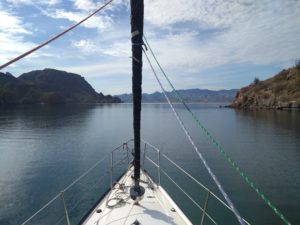
Curiel’s descriptions of Baja may well ring true for those who’ve sailed here: revelling in the unspoiltness of the place, but worrying about where to get essential provisions and water, loving the isolation but missing internet access, stunned by the scenery or weathering out the wild winds. It is, according to Curiel “very noble, but also ¡una hija de la chingada! A paradise, and a hell, a contradiction, an anachronism.” He’d describe himself the same way, he jokes. And Mexico? “It’s waking up!”
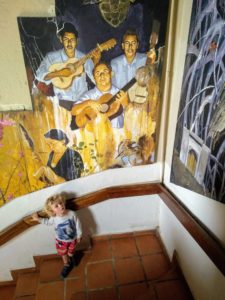 Maybe that’s what his art can do for us, too. Something of an awakening, after weeks of exploring the area. Standing in the cool staircase, watching the office staff head out to do errands or people bringing in paperwork surrounded by all this life and colour on the walls, there’s a sudden sense of the place, an implication and an invitation, a feeling of being allowed inside the living history of a town that is, and always has been, so much more than its famous mission and coastline.
Maybe that’s what his art can do for us, too. Something of an awakening, after weeks of exploring the area. Standing in the cool staircase, watching the office staff head out to do errands or people bringing in paperwork surrounded by all this life and colour on the walls, there’s a sudden sense of the place, an implication and an invitation, a feeling of being allowed inside the living history of a town that is, and always has been, so much more than its famous mission and coastline.
Curiel’s top tips for your visit to Loreto and the region:
- Historical sites you shouldn’t miss: the mission museum, the San Javier mission up in the mountains
- Go to the islands! Isla Coronado, Isla del Carmen with the rusting ruins of saltworks, Isla Danzante.
- Go up the Tabor canyon, just in front of the entrance to Puerto Escondido. Or the Mezquitito canyon, the entrance is under the bridge of Ensenada Blanca, Hotel Villa del Palmar (at what we know as Candaleros Bay)
- Have breakfast in Pan Que Pan Bakery. Eat in Orlando’s for typical Mexican food and for good steaks try Domingo’s place at the entrance to the town. For drinks try El Zopilote brewery, right by the main square, or Mike’s Bar. For icecreams and popsicles don’t miss La Michoacana.
Other local artists to check out: The classics: Carlos Olachea, Aníbal Angulo, Efrén Olalde, Armando Manríquez. The new generation: Daniel Amora, Elti Alejandro López, Gabriel Rodríguez and street artist Uli Martinez.

We hoped to take Curiel out for a sail or at least share a few drinks on board, but timings didn’t work out. If you’re in the area, interested in art, and want to get a unique work for your boat or home, make sure you look him up – and maybe take him out for a beer or something! And go along on one of the ArtWalks to support him and other local artists.
FIND OUT MORE:
Alejandro Curiel’s website is here, and find him on Facebook here and on Instagram here.
A bit more information about the founding of Loreto, in Spanish, is here.
A bit more information about the visual arts scene in Baja California Sur, in Spanish, is here. More work from local artists here.
A version of this post, with a bit more discussion of Curiel’s art, can also be found here on www.spanishcultureshared.wordpress.com.
